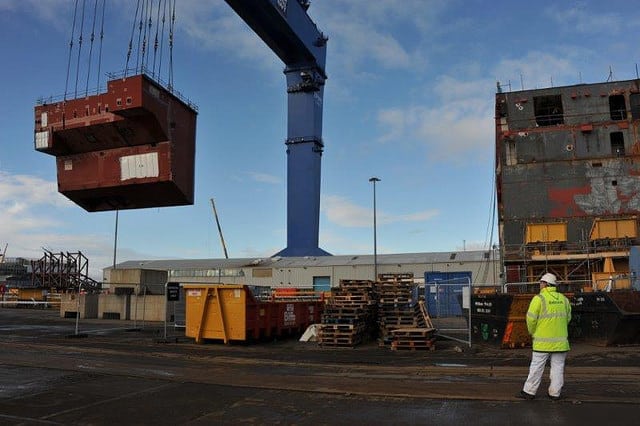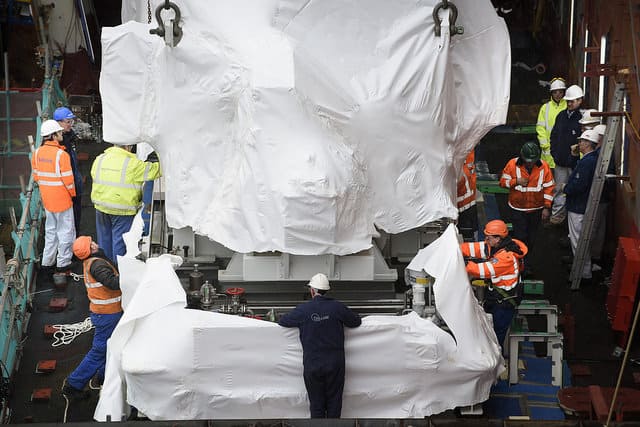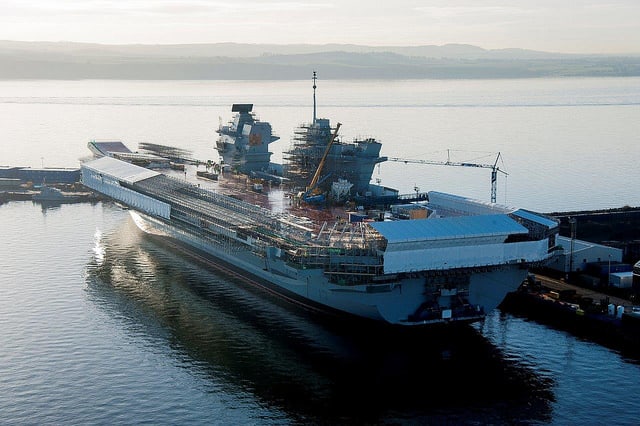As I write this the first 500 tonnes of dieso fuel has just finished being embarked onto HMS Queen Elizabeth the first of two giant aircraft carriers being assembled and commissioned at Rosyth by the Aircraft Carrier Alliance (ACA) for the Royal Navy. This is part of the preparations being made for starting to run the ship’s diesel generators which will then allow the 11,000V High Voltage system to be energised by the ship’s equipment and the low voltage supplies to be derived from the HV. For the first time the ship will be live without being reliant on a shore electrical supply.
Starting the diesel engines is scheduled to occur in May and the ACA are working hard to achieve that date. Once the diesels are running it will be possible to start to commission the power and propulsion systems through the propulsion converters and eventually leading to turning the shafts. A temporary HV cable is being installed across the flight deck to a load bank ashore so that the generators can be load tested up to full power, and with a total of 110MW of power generation capability aboard, including the gas turbines, there is a lot of energy to be absorbed, either through the shafts and the brake propeller blades or through the load bank or a combination of the two.

The sixth drop of software for the Integrated Platform Management System (IPMS) has passed its factory acceptance testing at L3’s test facility in Bristol and is now available to be installed on the ship’s hardware. This will provide the commissioning engineers working on the platform systems with functionality which will allow them to progress in setting the ship’s systems to work.
The network of fibre optics that make up the ships Integrated Network Environment which provide the backbone on which the IPMS and the various Command and Control systems run is making good progress in being installed and progressively set to work. Both the Ship Control Centre and the Operations Room now have live computer screens displaying real data.
The second ship HMS Prince of Wales is also making good progress in the build dock at Rosyth. The first of the two Rolls Royce MT30 Gas Turbines have been installed onto the sponson on the starboard side, and the enclosing sponson structural blocks have been installed around it. The remaining starboard side sponson blocks are in the process of being installed, while on the port side the first part of the catwalk has been installed. Already the full 70m width of the flight deck is visible. It is less than a year since we floated HMS Queen Elizabeth out of the dock, yet looking from the project office at the head of the dock we can already see a second aircraft carrier taking shape.

Away from Rosyth Lower Block 04 of Prince of Wales, which completes the aft part of the hull is progressing at the Govan shipyard and will be transported to Rosyth later this year.
The capacity of the Queen Elizabeth Class integrated communications system has been successfully demonstrated in a large scale trial at the Royal Navy Training School HMS Collingwood on the South coast. This three day trial involved 70 serving Royal Navy personnel operating 120 Tactical Voice Terminals linked through a fibre optic network in the same way as they will be on the ship, and tested the system well beyond its designed capacity. More than 20,000 operator actions were made over the course of the three days, proving that the system can run 600 active phones while still supporting 1,100 concurrent group and open line users.

In February 17(Reserve) Squadron became the first UK squadron operating the F35B Lightning 2 jet aircraft when they started operational testing with the first of the UK’s aircraft at Edwards Airforce base in the USA. 17 Squadron was formed in 1915 and to mark the 100th anniversary of the squadron a fly past with the F35B has taken place in front of the Chief of the Airstaff. This squadron manned by RAF and Royal Navy flight crew and engineers are now operating and maintaining the aircraft completely separately from their US colleagues which is an important step towards the first flying trials with HMS Queen Elizabeth off the east coast of the USA in 2018.
At the aircraft carrier’s home port at Portsmouth Naval Base, preparations are being made for HMS Queen Elizabeth to arrive having completed initial sea trials in late 2016 or early 2017. These preparations include everything from civil engineering work to prepare the jetties and provide for a High Voltage shore supply to arranging for the office accommodation and car parking that will be required for the ship’s crew and contractors needed to operate and support the aircraft carrier in service.




Project to investigate hybrid approach to titanium manufacturing
Sadly they will not be ordering any more presses from Wilkins & Mitchell http://www.historywebsite.co.uk/articles/Darlaston/WM.htm